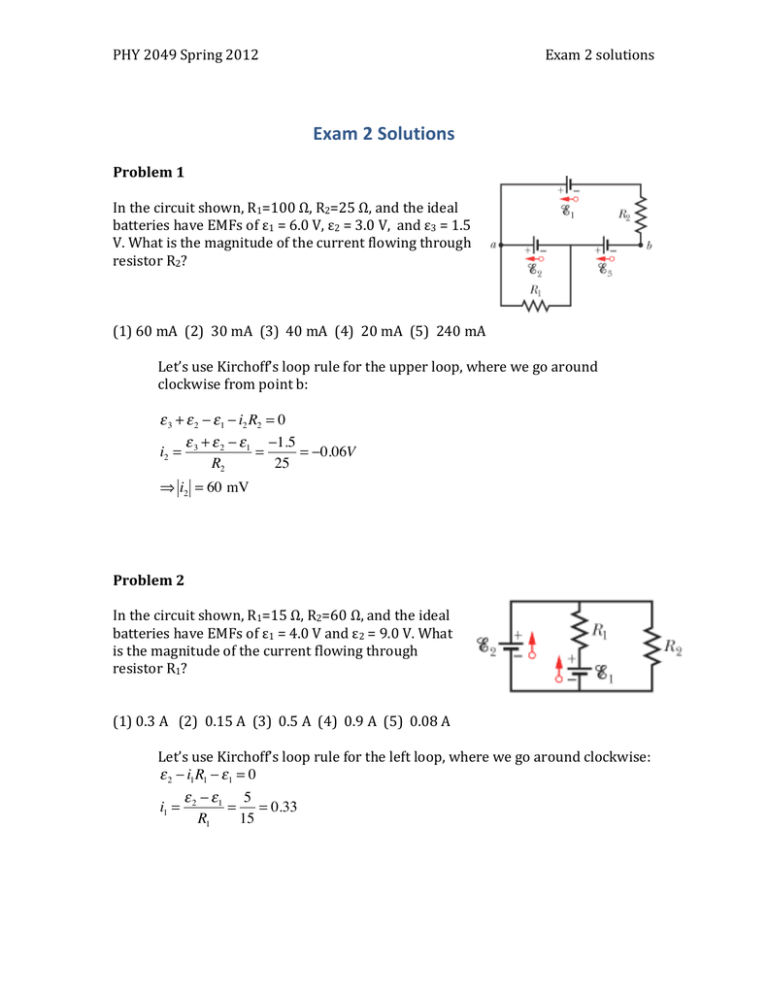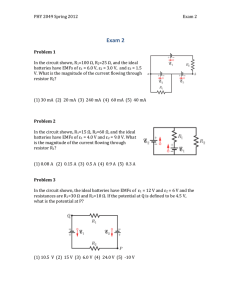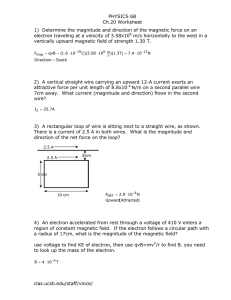Document 10455421
advertisement

PHY 2049 Spring 2012 Exam 2 solutions Exam 2 Solutions Problem 1 In the circuit shown, R1=100 Ω, R2=25 Ω, and the ideal batteries have EMFs of ε1 = 6.0 V, ε2 = 3.0 V, and ε3 = 1.5 V. What is the magnitude of the current flowing through resistor R2? (1) 60 mA (2) 30 mA (3) 40 mA (4) 20 mA (5) 240 mA Let’s use Kirchoff’s loop rule for the upper loop, where we go around clockwise from point b: ε 3 + ε 2 − ε1 − i2 R2 = 0 ε + ε − ε −1.5 i2 = 3 2 1 = = −0.06V R2 25 ⇒ i2 = 60 mV Problem 2 In the circuit shown, R1=15 Ω, R2=60 Ω, and the ideal batteries have EMFs of ε1 = 4.0 V and ε2 = 9.0 V. What is the magnitude of the current flowing through resistor R1? (1) 0.3 A (2) 0.15 A (3) 0.5 A (4) 0.9 A (5) 0.08 A Let’s use Kirchoff’s loop rule for the left loop, where we go around clockwise: ε 2 − i1 R1 − ε1 = 0 ε −ε 5 i1 = 2 1 = = 0.33 R1 15 PHY 2049 Spring 2012 Exam 2 solutions Problem 3 In the circuit shown, the ideal batteries have EMFs of ε1 = 12 V and ε2 = 6 V and the resistances are R1=30 Ω and R2=10 Ω. If the potential at Q is defined to be 4.5 V, what is the potential at P? (1) 15.0 V (2) 10.5 V (3) 6.0 V (4) 24.0 V (5) -­‐10 V First solve for the current in the circuit: ε1 − iR2 − ε 2 − iR1 = 0 ε −ε 6 i= 1 2 = = 0.15 R1 + R2 40 Now let’s add the potential difference to go from point Q to P: VP = VQ + ε1 − iR2 VP = 4.5 + 12 − 0.15 (10 ) = 15 PHY 2049 Spring 2012 Exam 2 solutions Problem 4 In the shown figure, R1 = R2 = R3 = 50 Ω, R4 = 100 Ω, and the ideal battery has EMF = 6 V. What is the equivalent resistance of the circuit? (1) 70 Ω (2) 120 Ω (3) 20 Ω (4) 90 Ω (5) 250 Ω The 3 resistors R2, R3, and R4 are in parallel with equivalent resistance: R234 ⎛ 1 1 1⎞ =⎜ + + ⎟ ⎝ R2 R3 R4 ⎠ −1 ⎛ 5 ⎞ =⎜ ⎝ 100 ⎟⎠ −1 = 20 Then adding resistor R1 in series we have Req=50+20=70Ω Problem 5 A capacitor with an initial potential difference of 50 V is discharged through a 106 Ω resistor when a switch between them is closed at t=0. At t=2 s, the potential difference across the capacitor is 25 V. What is the capacitance of the capacitor? (1) 2.9x10-­‐6 F (2) 2.0x10-­‐6 F (3) 3.5x105 F (4) 3.5x10-­‐7 F (5) 0.5 F q ( t ) q0 −t /RC V= = e C C −t /RC ⇒ V = V0 e V0 = 50 V ( 2 ) = 25 = 50e−2/RC 2 RC 2 ⇒C = = 2.9 × 10 −6 F R ln 2 ⇒ ln 2 = PHY 2049 Spring 2012 Exam 2 solutions Problem 6 An ion of charge q= +2e and unknown mass is sent into a region with a uniform magnetic field of magnitude B=0.5 T as shown in the figure. The charged ion makes a U-­‐turn in the region of the magnetic field as a semicircle of radius 1 m and exits after a time t=7.8 x10-­‐6 s. What is the mass of the ion in kg? (1) 4.0x10-­‐25 (2) 1.6x10-­‐19 (3) 2.0x10-­‐25 (4) 1.2x10-­‐24 (5) 1.0x10-­‐25 We can use the relation between momentum and radius of curvature for a particle moving in a magnetic field: mv = qBr qBr ⇒m= v The velocity can be found from the time it takes to complete the semicircle: d = π r = vt πr π ⇒v= = = 4 × 10 5 m/s −6 t 7.8 × 10 s So the mass is given by −19 qBr 2eBr 2 (1.6 × 10 ) ( 0.5 )1 m= = = = 4 × 10 −25 kg v v 4 × 10 5 This is the mass of Uranium. PHY 2049 Spring 2012 Exam 2 solutions Problem 7 A beam of electrons (``cathode rays'') with a velocity of v = 3.0x107 i m/s is sent into a region where there is a uniform magnetic field of B = 5.0x10-­‐4 j T. What electric field E is necessary (direction and magnitude) so that the electrons continue traveling in a straight line without deflection by the magnetic field? (1) -­‐1.5x104 k T (2) 1.5x104 k T (3) 5.0x10-­‐4 j T (4) -­‐5.0x10-­‐4 j T (5) 2.4x10-­‐15 i T The Lorentz Force equation is F = q ( E + v × B ) So the condition of no net force (so no deflection) is: E = −v × B ( ) ( ) = − 3 × 10 7 î × 5 × 10 −4 ĵ = −1.5 × 10 4 k̂ Problem 8 An electron moves in the -­‐i direction, through a uniform magnetic field in the -­‐j direction. The magnetic force on the electron is in the direction: (1) -­‐k (2) k (3) -­‐j (4) j (5) -­‐i The magnetic force is FB = qv × B So working with directions only: F = ( −e) − î × − ĵ = − k̂ ( ) ( ) PHY 2049 Spring 2012 Exam 2 solutions Problem 9 The figure shows a rectangular loop of wire of dimensions 10 cm by 5.0 cm. It carries a current of 0.2 A and it is hinged along one long side. It is mounted in the xy plane, and it makes an angle of Θ=30° to the direction of a uniform magnetic field of 0.25 T. What is the magnitude of the torque acting on the loop about the hinge line? (1) 2.2x10-­‐4 N m (2) 1.3x10-­‐4 N m (3) 5.0x10-­‐3 N m (4) 1.0x10-­‐3 N m (5) 0 Nm The torque on the loop is calculated below. Note that the angle between the magnetic dipole moment and the magnetic field is 90° + θ, or 120°. τ =µ×B ⇒ τ = µ Bsin θ µ = iA = ( 0.2A ) ( 0.05m ) ( 0.01m ) τ = ( 0.2A ) ( 0.05m ) ( 0.01m ) ( 0.25T ) sin120 τ = ( 0.2A ) ( 0.05m ) ( 0.01m ) ( 0.25T ) τ = 2.2 × 10 −4 Nm 3 2 Problem 10 A magnetic field CANNOT: (1) change the kinetic energy of a charge (2) exert a force on a charge (3) accelerate a charge (4) change the momentum of a charge (5) exist The only thing a magnetic field cannot do is perform work on an object, hence it cannot change the kinetic energy of a charge. PHY 2049 Spring 2012 Exam 2 solutions Problem 11 Two wires are aligned with x-­‐ and y-­‐axes and carry currents I1 along x-­‐axis and I2 along y-­‐axis as shown. Which of the four quadrants have points in (x, y)-­‐plane where the magnetic field is zero. (a) 1 & 3 (b) 2 & 4 (c) all (d) none (e) the answer depends on the relative magnitudes of the two currents Answer: Using right hand rule (align the right hand thumb along the current and curl the fingers around the thumb), the direction of magnetic fields induced by the currents are as follows: Current Quadrant 1 Quadrant 2 Quadrant 3 Quadrant 4 I1 out out in in I2 in out out in Hence, the two fields can potentially cancel only in quadrants 1 and 3, where they point in different directions. This eliminates answers (b) and (c). The magnitudes of fields in Quadrant 1 are: µ I µ I B1 = 0 1 and B2 = 0 2 2π y 2π x The two fields are equal in magnitude along the line: I y= 1x I2 Hence, the net field along this line is zero. The exact same argumentation holds true for Quadrant 3. Therefore, the right answer is (a) PHY 2049 Spring 2012 Exam 2 solutions Problem 12 One wire is aligned with x-­‐axis and carries currents I1=1A. Another wire carries current I2=2 A out of page through the point (x, y)=(0 m, 1 m) as shown. What is the magnitude of the magnetic field in Tesla at point P(3 m, 1 m)? (a) 2.4E-­‐7 (b) (b) 3.3E-­‐7 (c) (c) 6.7E-­‐8 (d) (d) 1.5E-­‐6 (e) (e) 4.2E-­‐7 Answer: Using right hand rule (align the right hand thumb along the current and curl the fingers around the thumb), the direction of magnetic fields induced by the two currents at point P are as follows: Current I1 µ I 1 out of the page; its magnitude is B1 = 0 1 = 2 ⋅10 −7 = 2 ⋅10 −7 T 2π y 1 Current I2 µ I 2 up; its magnitude is B2 = 0 2 = 2 ⋅10 −7 = 1.333⋅10 −7 T 2π x 3 Since the two fields are perpendicular to each other, we use the Pythagorean theorem for calculating the total field magnitude: BTOT = 2.4 ⋅10 −7 T PHY 2049 Spring 2012 Exam 2 solutions Problem 13 A current I through an infinitely long wire increases. A square loop made of a conductor is placed next to the wire carrying the current as shown (the loop and the wire are in the plane of the sheet). What is the direction of a net force exerted on the loop? (a) down (b) up (c) out of the page (d) into the page (e) zero Answer: As the current increases, so does the flux of magnetic field through the loop. The field is into the page, so is its flux through the loop. Since the current I is increasing, the flux is also increasing. The change in the flux is into the page. dΦ Induced EMF, E = − , is dt counterclockwise (right hand thumb is along the change in the flux, curl your fingers, and change the direction). The induced currents (shown in red), being in the magnetic field of the wire, will experience forces as follows: Up side of the loop: force F1, down Left side of the loop: F2, right Bottom side of the loop: force F3, up, but it is smaller than F1 as the filed is weaker away from the wire (B ~ I/r) Right side of the loop: F4, left, same in magnitude as F2, by symmetry Therefore, F2 and F4 cancel each other and the net force of F1 and F3 points down. PHY 2049 Spring 2012 Exam 2 solutions Problem 14 A prism with sides 2, 3, 4 cm is placed in uniform magnetic field of 1 T pointing along y-­‐direction (see drawing). Find the magnetic field flux (in Webbers) through the entire surface area of the prism. (a) 0 (b) 10 × 10-­‐4 (c) 8 × 10-­‐4 (d) 18 × 10-­‐4 (e) 16 × 10-­‐4 Answer: Φ = B ⋅ A ⋅ cosθ , where θ is an angle between a vector normal to a surface of area A and a vector of a magnetic field of strength B. a) The flux through the front, back, and bottom sides of the prism are zero since the field is parallel to these three surfaces (θ=90°, cosθ=0). b) The flux through the left side is (1 T) × (0.04 × 0.02 m2) , inward c) The right side of the prism has sides 2 cm (as marked) and 5 cm (from Pythagorean theorem). The angle between a vector normal to a surface of the right side and the magnetic field vector is the same as top angle of the front side of the prism. Cosine of that angle is 4/5. Therefore, the flux through the right side is (1 T) × (0.05 × 0.02 m2) × (4/5), outward. d) The net flux through all five surfaces is: 0 + 0 + 0 + (-­‐0.008) + (+0.008) = 0 PHY 2049 Spring 2012 Exam 2 solutions Problem 15 Answer: Magnetic field inside the solenoid is B = µ0 In , where n=1000/(0.2 m). Induced EMF is ΔΦ Ba 2 µ0 In ⋅ a 2 µ0 I ⋅(N / L)⋅ a 2 4π ⋅10 −7 ⋅3⋅(1000 / 0.2)⋅ 0.012 E = = = = = = 6.28⋅10 −7 V Δt Δt Δt Δt 0.3 Problem 16 Answer: Induced EMF is ΔΦ Bπ r 2 N − (−Bπ r 2 N ) 2Bπ r 2 N 2 ⋅ 50 ⋅10 −6 ⋅3.14 ⋅ 0.52 ⋅ 25 E = = = = = 9.8⋅10 −3 V Δt Δt Δt 0.2 PHY 2049 Spring 2012 Exam 2 solutions Problem 17 Answer: The magnetic filed integral over a loop is related to the total current going through the loop. The current is counted as positive if it is in the same direction as the right hand thumb points, when fingers are curled around the loop in the direction of integration. −7 −7 ∫ B ds =µ0 ITOT = 4π ⋅10 ⋅(−1 + 2 − 3 + 3) = 4π ⋅10 Tm Problem 18 Answer: dΦ d d d 1 E = = Bπ r 2 N = B0 e −t/τ π r 2 N = B0π r 2 N e −t/τ = B0π r 2 N e −t/τ dt dt dt dt τ PHY 2049 Spring 2012 Exam 2 solutions Problem 19 Answer: The total energy U is energy density u = 1 2 B 2 µ0 times the inner volume of the solenoid π r 2 L : ⎛ 1 2⎞ ⎛ ⎞ 42 U =⎜ B ⎟ π r2L = ⎜ ⋅ 3.14 ⋅32 ⋅12 = 2 ⋅10 9 J −7 ⎟ ⎝ 2 ⋅3.14 ⋅10 ⎠ ⎝ 2 µ0 ⎠ ( ) ( ) Problem 20 Answer: The sum of difference potentials over all elements in the closed loop of any circuit is zero. Right after closing the switch, the sum of difference potentials over all elements in the circuit is: ΔVbattery + ΔVinductor + ΔV fuse + ΔVswitch = 0 dI ⎞ ⎛ E + ⎜ −L ⎟ + 0 + 0 = 0 ⎝ dt ⎠ dI E = dt L I= E t L From where, it takes 1.5 s to reach 3A current.






